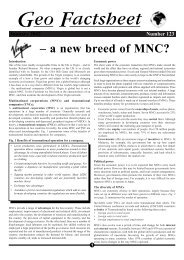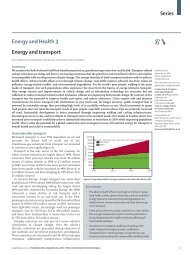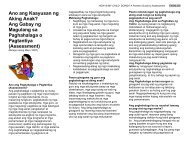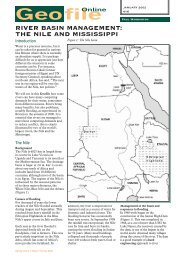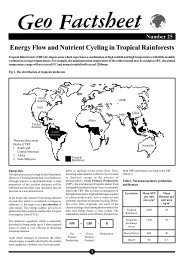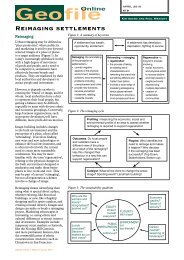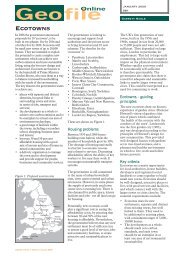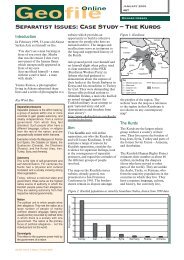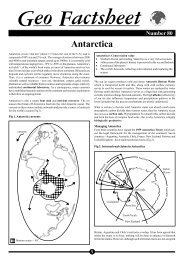April 2007 no.545 Corries, arêtes <strong>and</strong> <strong>py</strong>ramidal peaksLocation determines the speed ofthis transformation into ice whichcan take up to 200 years in dryenvironments such as Greenl<strong>and</strong>where snowfall may only be 10mmper annum, to a shorter time framein warmer <strong>and</strong> moister climaticzones.Figure 3: Erosional activity in a corrieBergschrund – allows meltwater <strong>and</strong>material weathered by freeze-thaw toenter body of iceCrevasses (olderbergschrunds)Pivot of rotationTogether with the unique terrain onwhich each individual snow patch isfound, the snow patch graduallyetches itself into the hillside by aprocess called nivation, wherebyfreeze-thaw action, solifluction <strong>and</strong>rotational movement erode back intothe hollow, creating a steepheadwall.ExtendingflowRotationalmovementCrevasses dueto bendingof iceFor a glacier to develop, a prolongedperiod of ice accumulation is needed.This extends into thous<strong>and</strong>s ofyears. Any shorter period would notallow sufficient accumulation of iceto occur or for the ice, which flowsunder gravity, to be replaced at itssource <strong>and</strong> enable a glacier to flow.Geologists <strong>and</strong> geomorphologistsstudying mountainous areascontaining corries, arêtes <strong>and</strong><strong>py</strong>ramidal peaks believe that thesefeatures are not the result of oneglacial period but a whole series ofglacial activities. In the British Isles<strong>and</strong> <strong>No</strong>rthern Europe, over 40 iceadvances have been identified; themost recent glaciation covering<strong>No</strong>rthern Britain <strong>and</strong> <strong>No</strong>rthernEurope ended only 10,000 years ago.The formation of a corrieA corrie develops on the highermountain slopes where snowaccumulates, compacts, becomes ice<strong>and</strong> then moves under gravity <strong>and</strong> isreplaced by new snow <strong>and</strong> later iceensuring a continuous glacial flow(Figure 3). The former pre-glacialhollow is enlarged <strong>and</strong> deepened asa result of nivation. Once the iceaccumulated in the glacier hasachieved an optimum weight <strong>and</strong>depth <strong>and</strong> it begins to flowdownhill, rotational movement willenable plucking <strong>and</strong> abrasion to acton the base of the hollow. Thisaction will cause the deepening ofthe hollow. Material eroded by theice will be transported by the iceeither within its bulk or bymeltwater caused by frictionbetween the solid rock <strong>and</strong> the iceitself. This will allow the flow ofsome material acting as a protectivelayer <strong>and</strong> allow further deepening ofthe corrie to take place.Rate of deepeningdepends upon theresistance of bedrockThe surface of the glacier will bemarked with bergschrunds, orcrevasses, which allow meltwater<strong>and</strong> rock debris, the result of freezethaw on the exposed mountainsides,to enter the mass of ice. Thebergschrund forms wherecompacted firn pulls away from theice frozen to the rock of theheadwall, leading to headwarderosion <strong>and</strong> the subsequent erosion<strong>and</strong> retreat of the mountainside.Similarly, the meltwater aids theprocess of freeze-thaw, while thedebris may be carried in the mass ofthe ice or make its way to the base ofthe glacier where it can act as anabrasive tool.Most of this deepening occurs onthe back wall <strong>and</strong> the rear of thehollow where the gradient is steeper.Where the glacier levels out <strong>and</strong> thegradient is less, the erosive powersof the glacier diminish <strong>and</strong>deepening of the hollow becomesless. This leads to the developmentof a small lip over which the ice willflow before following the formerriver course or earlier glacial coursedown its valley.These processes are happeningtoday in glacial regions such asSweden where the Kebnekaisecirque glacier occupies a hollow <strong>and</strong>is acting in the manner that hasbeen described. Other areas of theworld display corries after the icehas disappeared <strong>and</strong>geomorphologists <strong>and</strong> geologistsneed to be able to study both stagesof development to underst<strong>and</strong> theintricacies involved in corrieformation.GeoFile Series 25 Issue 3Fig 545_03 Mac/eps/illustrator 11 s/sNELSON THORNES PUBLISHINGArtist: David Russell IllustrationlipCompressiveflowFlow toU-shapedvalleyThe corries in the ScottishCairngorms have been closely studied<strong>and</strong> their formation in the Quaternaryperiod, which in geological termsrelates to the last two million years,suggests that they were a feature oflocalised mountain glaciation. Manyhollows were wholly or partly filledbut their flow away from their sourceenabled larger valley glaciers to form.The corries display signs of multipleglaciation. The glacial deposits ormoraines found in examples of corriessuch as Coire an t-Sneacdha are smallcompared to the size of the corrie <strong>and</strong>indicate that transportation by the ice<strong>and</strong> post glacial ice melt haveremoved much of this material. Forin-depth case study of Coire an t-Sneachda visit www.fettes.co./cairngorms/coire%20Sneachda.Studies in the Cairngorms have foundthat 70 to 90% of corries\wereorientated between north <strong>and</strong> east,matching similar studies relating tocorrie orientation. It was alsosuggested that the current size of thecorries investigated was reached aboutone million years ago <strong>and</strong> with theonset of later glaciations the valleyglaciers were over-ridden by ice sheetswhich covered the whole area.Evidence suggested for this is theremoval of pinnacles of rock <strong>and</strong>ridges associated with the back wall ofa corrie such as that as seen at Fiacailla’Choire Chais.Geofile Online © Nelson Thornes 2007
April 2007 no.545 Corries, arêtes <strong>and</strong> <strong>py</strong>ramidal peaksFigure 4: Extent of ice cover in Europe in the Quaternary Ice AgeLake <strong>District</strong>SnowdoniaThe Thames–Severn lineCairngormsIcel<strong>and</strong>which separated one river systemfrom another in pre-glacial times.The best examples of arêtes in theUnited Kingdom are Crib Goch inSnowdonia (Grid Reference 605545,O.S. Sheet 115) <strong>and</strong> Striding Edge onHelvellyn in the English Lake<strong>District</strong> (Figure 5). At Striding Edge(Grid Reference 345149, OS Sheet 90)the serrated ridge is only a footpathwidth in places <strong>and</strong> as furtherheadward erosion occurs the ridgeitself will theoretically become lower<strong>and</strong> wider in time. One of the twocorries making up the arête contains atypical corrie lake otherwise known asa tarn. This is Red Tarn (GridReference 348153, O.S. sheet 90)which occupies the over-deepenedhollow created by the ice.PyreneesAs can be seen from Figure 4,glaciation in the British Islesextended northwards of a line roughlystretching west-east from the Severnestuary to just north of the Thamesestuary. The mountainous areascontained north of this line includeSnowdonia, the English Lake <strong>District</strong><strong>and</strong> the Scottish Cairngorms.Evidence of mountain glaciation <strong>and</strong>subsequent corrie development isevident in all three of these regions.Alpserosion <strong>and</strong> over-deepeningassociated with such activity will leadto the formation of a ridge betweenthe two headwalls of the corries. Thissharp serrated ridge is called an arête<strong>and</strong> marks the remains of the formerinterfluve, or broad upl<strong>and</strong> ridge,GeoFile Series 25 Issue 3Fig 545_04 Mac/eps/illustrator 11 s/sNELSON THORNES PUBLISHINGArtist: David Russell IllustrationKeyIce sheetsPyramidal peaksA <strong>py</strong>ramidal peak is formed whenthree or more glaciers radiateoutwards from one mountain <strong>and</strong> theheadward erosion <strong>and</strong> all the erosiveactivities associated with corrieformation are replicated on each sideof the mountain. This leads to theclassic <strong>py</strong>ramid shape with a sharppeak. The classic <strong>py</strong>ramidal peak isthe Matterhorn, in the Swiss Alps.Figure 5: Striding Edge, an example of an arête <strong>and</strong> a corrie lakeWhen studying an Ordnance Surveymap extract of such an area adistinctive pattern of contour linesindicates the presence of a corrie. Aclose pattern of contour lines in analmost crescent shape indicates thesteep back wall of the corrie <strong>and</strong> anarea lacking in contours indicates thehollow where over-deepeningoccurred. This is often filled with alake or tarn, the alternative name forthe corrie lake. The ‘front’ of thecorrie is marked by a further contourwhere the l<strong>and</strong> rises (the lip),indicating where erosion was less <strong>and</strong>behind which the lake can accumulatein post-glacial times.ArêtesIf an upl<strong>and</strong> area supported two rivervalleys flowing in different directionsin pre-glacial times, the onset ofglaciation may lead to thedevelopment of two glaciers. If this isthe case, the actions associated withthe formation of a corrie will beoccurring in more than one locationat the same time. The headwardFigure 6: World Examples of Pyramidal PeaksNameMount AssiniboineInnerdalstarnetShivlingAma DablanCnicht *Location of ‘Pyramidal Peak’‘Matterhorn’ of the Rockies‘Matterhorn’ of <strong>No</strong>rway‘Matterhorn’ of India‘Matterhorn’ of the Himalayas‘Matterhorn’ of Wales* Perhaps the least convincing example due to its low elevation (2265ft/697m)<strong>and</strong> lack of steepness <strong>and</strong> classic <strong>py</strong>ramid shape.Geofile Online © Nelson Thornes 2007



